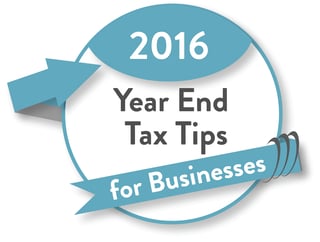 The fourth quarter of the year is an opportune time for businesses to purchase equipment to reap tax benefits.
The fourth quarter of the year is an opportune time for businesses to purchase equipment to reap tax benefits.
There’s a lot of take advantage of this year. For larger equipment, there’s both Section 179 and Bonus Depreciation. The federal government extended both business benefits in late 2015, making this tax year a prime chance to take advantage of them.
Section 179 Depreciation allows companies to immediately write off equipment purchases up to $500,000 while Bonus Depreciation offers an additional or separate opportunity to write off 50% of an asset right away. Bonus Depreciation will drop to 40% in 2018 and 30% in 2019, so 2016 or 2017 provides the best opportunity for the most tax savings.
READ MORE: Reduce Your Tax Burden: Year End Strategies for Businesses
There’s also increased opportunities to deduct small business purchases. Also in late 2015, the IRS increased the limit from $500 to $2,500 for deducting certain capital items.
 The so-called safe harbor election allows taxpayers to write off small dollar (or de minimis) expenditures for the acquisition or improvement of property. The new $2,500 threshold applies to any “functionally interdependent” unit of property, as substantiated by an invoice. If these conditions are met, costs that a business would otherwise have to capitalize and depreciate over a number of years for tax purposes can instead be deducted in the year of purchase.
The so-called safe harbor election allows taxpayers to write off small dollar (or de minimis) expenditures for the acquisition or improvement of property. The new $2,500 threshold applies to any “functionally interdependent” unit of property, as substantiated by an invoice. If these conditions are met, costs that a business would otherwise have to capitalize and depreciate over a number of years for tax purposes can instead be deducted in the year of purchase.
This new $2,500 threshold was effective starting January 1, 2016, however, the IRS will not challenge the use of the new $2,500 threshold in tax years prior to 2016, as long as the taxpayer meets certain requirements. These requirements include having a written accounting policy in place at the beginning of the year effectively adopting the $2,500 amount and, also, treating these purchases as an expense on their financial statements.
This safe harbor election is not only useful for lower cost items, but large purchases of lower cost items that add up to big ticket items. While Section 179 or Bonus Depreciation might be used for a $500,000 piece of machinery, the safe harbor election could be used to purchase $100,000 worth of new computers, assuming each computer was $2,500 each or less.
READ MORE: 5 Fourth Quarter Tax Planning Ideas Every CFO Needs
An advantage to the safe-harbor expensing election for businesses: Unlike Section 179 Depreciation, there is no maximum on the amount that can be deducted under the safe harbor election.
Here are two examples of how it can be used:
Example 1: A restaurateur purchases three commercial toasters for his restaurant. Each toaster has a cost of $2,100. Because each toaster can function on its own and has a cost of less than $2,500 per item, the restaurateur can expense and deduct these toasters in the year of purchase, rather than depreciating them over time.
Example 2: A manufacturer pays $2 million to buy 800 machines at $2,500 each. The company receives an invoice from its supplier indicating the total amount due ($2 million) and the price per item ($2,500). Since each machine is a separate unit of property – and the amounts paid for them meet the requirements for the de minimis safe harbor – the company can then deduct the entire $2 million in the year the equipment is purchased and put into operation.
Note, for taxpayers with an applicable financial statement (i.e. audited financial statements), the de minimis or small-dollar threshold remains at $5,000. Most small businesses will qualify for the $2,500 level.





